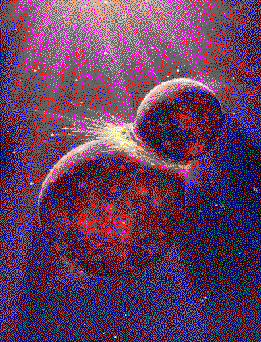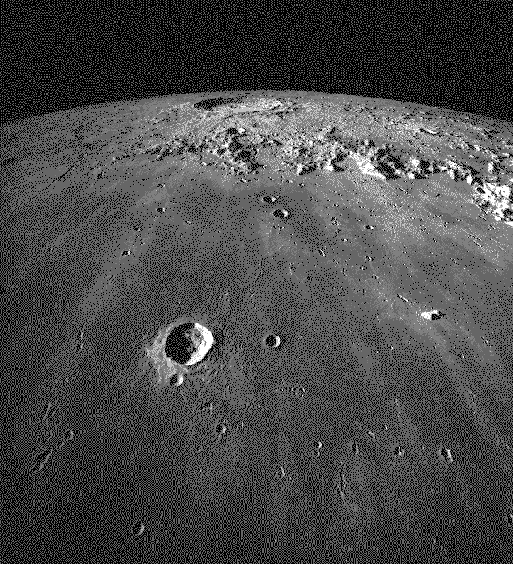Any model of Solar System formation must explain the following facts:
- 1. All the orbits of the planets are prograde (i.e. if seen from above the North pole of the Sun
they all revolve in a counter-clockwise direction).
- 2. All the planets (except Pluto) have orbital planes that are inclined by less than 6 degrees with respect
to each other (i.e. all in the same plane).
- 3. Terrestrial planets are dense, rocky and small, while jovian planets are gaseous and large.

I. Contraction of insterstellar cloud
- Solar system formed about 4.6 billion year ago, when gravity pulled together
low-density cloud of interstellar gas and dust (called a nebula)(movie).
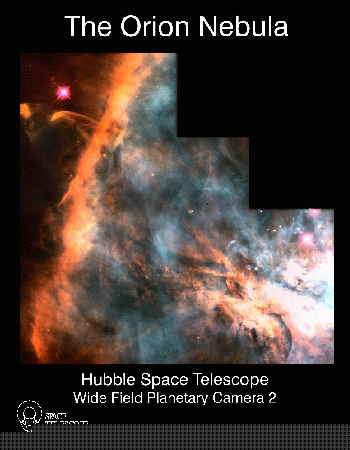 The Orion Nebula, an interstellar cloud in which star
systems and possibly planets are forming.
The Orion Nebula, an interstellar cloud in which star
systems and possibly planets are forming.
- Initially the cloud was about several light years across. A small overdensity in the cloud caused the
contraction to begin and the overdensity to grow, thus producing a faster contraction -->
run away or collapse process
- Initially, most of the motions of the cloud particles were random, yet the nebula had a
net rotation.
As collapse proceeded, the rotation speed of the cloud was gradually increasing due
to conservation of angular momentum.
 Going, going, gone
Going, going, gone
- Gravitational collapse was much more efficient along the spin axis, so the rotating ball collapsed into thin disk
with a diameter of 200 AU (0.003 light years) (twice Pluto's orbit),
aka solar nebula (movie),
with most of the mass concentrated near the center.

- As the cloud contracted, its gravitational potential energy was
converted into kinetic energy of the individual gas particles.
Collisions between particles converted this energy into heat (random motions).
The solar nebula became hottest near the center where much of the mass was collected to
form the protosun(the cloud of gas that became Sun).
- At some point the central temperature rose to 10 million K. The
collisions among the atoms were so violent that nuclear reactions began,
at which point the Sun was born as a star, containing 99.8% of the total mass.
- What prevented further collapse? As the temperature and density increased toward
the center, so did the pressure causing a net force pointing outward. The Sun
reached a a balance between the gravitational force and the internal pressure, aka as hydrostatic equilibrium,
after 50 million years.

- Around the Sun a thin disk gives birth to the planets, moons, asteroids and comets. Over
recent years we have gathered evidence in support of this theory.
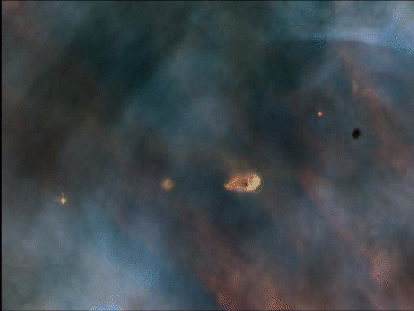
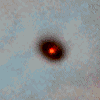
 Close-up of the Orion Nebula obtained with HST, revealing what seem to be disks of dust
and gas surrounding newly formed stars. These protoplanetary disks span about 0.14 light years and are probably similar
to the Solar Nebula.
Close-up of the Orion Nebula obtained with HST, revealing what seem to be disks of dust
and gas surrounding newly formed stars. These protoplanetary disks span about 0.14 light years and are probably similar
to the Solar Nebula.
II. The structure of the disk
- The disk contained only 0.2% of the mass of the solar nebula with particles moving in circular orbits.
The rotation of the disk prevented further collapse of the disk.
- Uniform composition: 75% of the mass in the form of hydrogen, 25% as helium, and all other elements comprising only 2% of the total.
- The material reached several thousand degrees near the center due to the release of gravitational energy --> it
was vaporized. Farther out the material was primarily gaseous because H and He remain gaseous even at very low T.
The disk was so spread that gravity was not strong enough to pull material and form planets.
- Where did solid seeds for planet formation come from? As the disk radiated
away its internal heat in the form of infrared radiation (Wien's law) the temperature dropped and the heaviest molecules
began to form tiny solid or liquid droplets, a process called condensation.
- There is a clear relation between the temperature and the weight of the particles that become solid (Why?).
Near the Sun, where the T was higher, only the heaviest compounds condensed forming heavy solid grains.
In the outskirts of the disk the T was low enough that hydrogen compounds lighter ice particles.
- The ingredients of the solar system fell into four categories:
- Metals: iron, nickel, aluminum. They condense at T~1,600 K and comprise only 0.2% of the disk.
- Rocks: silicon-based minerals that condense at T=500-1,300 K (0.4% of the nebula).
- Ices: hydrogen compounds like methane (CH4), ammonia (NH3), water (H2O) that condense at T~150 K
and make up 1.4% of the mass.
- Light gases: hydrogen and helium that never condensed in the disk (98% of the disk).

- The great temperature differences between the hot inner regions and the cool outer regions of the disk
determined what of condensates were available for planet formation at each location from the center. The
inner nebula was rich in heavy solid grains and deficient in ices and gases. The outskirts are rich in
ice, H, and He.
- Meteorites provide evidence for this theory.
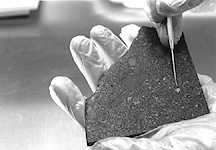 A piece of Allende meteorite showing white inclusions. The inclusions
are aluminum-rich minerals that formed first in the solar nebula. The inclusions are surrounded by
material with lower condensation temperatures which aggregated later.
A piece of Allende meteorite showing white inclusions. The inclusions
are aluminum-rich minerals that formed first in the solar nebula. The inclusions are surrounded by
material with lower condensation temperatures which aggregated later.



 The Orion Nebula, an interstellar cloud in which star
systems and possibly planets are forming.
The Orion Nebula, an interstellar cloud in which star
systems and possibly planets are forming.
 Going, going, gone
Going, going, gone




 Close-up of the Orion Nebula obtained with HST, revealing what seem to be disks of dust
and gas surrounding newly formed stars. These protoplanetary disks span about 0.14 light years and are probably similar
to the Solar Nebula.
Close-up of the Orion Nebula obtained with HST, revealing what seem to be disks of dust
and gas surrounding newly formed stars. These protoplanetary disks span about 0.14 light years and are probably similar
to the Solar Nebula.

 A piece of Allende meteorite showing white inclusions. The inclusions
are aluminum-rich minerals that formed first in the solar nebula. The inclusions are surrounded by
material with lower condensation temperatures which aggregated later.
A piece of Allende meteorite showing white inclusions. The inclusions
are aluminum-rich minerals that formed first in the solar nebula. The inclusions are surrounded by
material with lower condensation temperatures which aggregated later.
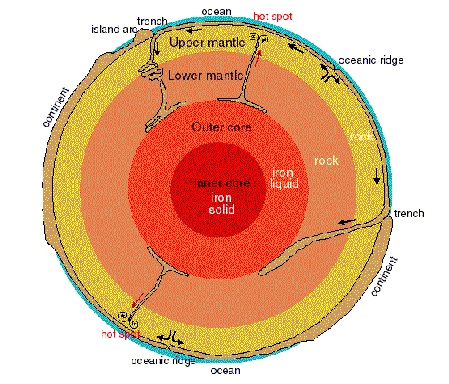 Inner structure of the Earth
Inner structure of the Earth
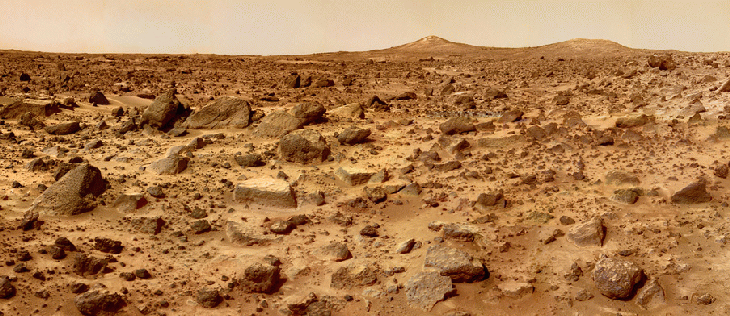




 Mars' moons: Phobos and Deimos
Mars' moons: Phobos and Deimos
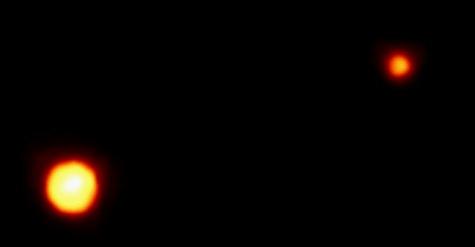 Pluto and Charon
Pluto and Charon
